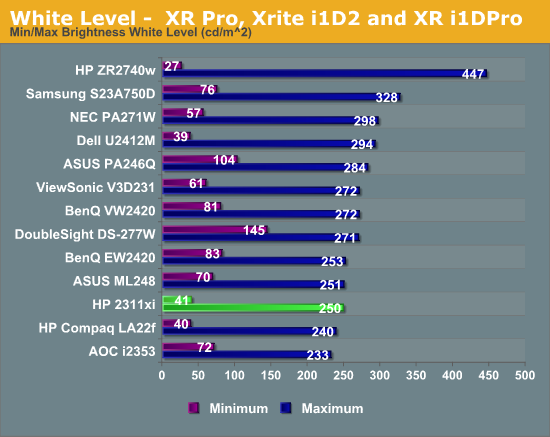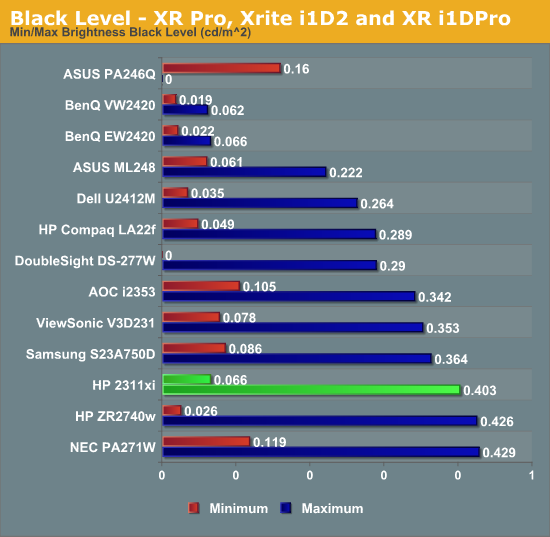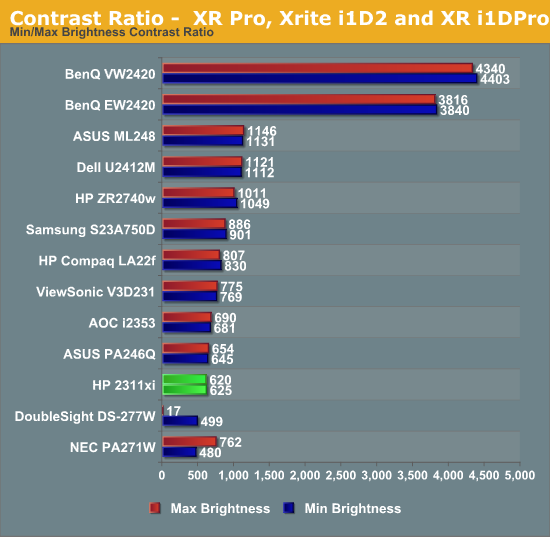HP 2311xi IPS Monitor
by Chris Heinonen on August 13, 2012 12:15 AM ESTHP 2311xi - Brightness and Contrast Ratios
HP rates the 2311xi for 250 nits maximum brightness and that’s exactly what I found it produced. If I turned the brightness all the way down it then put out only 41 nits, which gives you a lot of flexibility around adjusting the backlight level. 250 nits should be enough light output for most people, but if you have direct sunlight on your display for most of the day you might need something even more powerful to avoid it looking washed out.

For measuring the black levels, I made sure to leave the Dynamic Control off for the LEDs. With that enabled, it could potentially turn off the backlight completely, which would result in a black level of 0.000, but one that has no practical implications aside from a totally black screen. By leaving that disabled, we get a real-world measure of the black level. At maximum brightness, our black level is right around 0.4 nits, which is a little higher than other displays we have measured with similar peak white levels. The minimum level was 0.066, which correlates well with the white level change. Black levels are typically a little worse with IPS than with VA panels, which is the trade off for getting the other advantages an IPS display offers for color and viewing angles.

Looking at the contrast ratio, we are almost exact the same at minimum and maximum backlight, right around 620. I went ahead and measured this at 0-100% in increments of 10, and every measurement was between 620 and 625, so it’s a very consistent contrast ratio all across the range. It’s a perfectly normal and average contrast ratio, about what I’d expect from a budget IPS display.

Looking at the Brightness and Contrast numbers, the HP 2311xi is a decent but not exceptional performer. Nothing stands out, but everything about the performance so far is perfectly acceptable with the price involved.










68 Comments
View All Comments
XonicEQ - Monday, August 13, 2012 - link
Cheapest I can find is on amazon for $234. Where do I find it for $200?cheinonen - Monday, August 13, 2012 - link
Direct from HP.com was the price I used, and the date of that price should be mentioned in the specs. It might have changed by then, but it was from HP on the date I listed.EddieBoy - Monday, August 13, 2012 - link
As stated above, Best Buy currently has this monitor for sale for $169.99. Plus free shipping.Leyawiin - Monday, August 13, 2012 - link
HP's switch to crappy stands that don't adjust and lack of VESA holes on their lower end monitors is pretty disappointing. My last monitor was an HP w2207h - glossy screen, height adjustable, sturdy. Went shopping this summer for a new monitor and discovered how cheaply they're been making them now.micksh - Monday, August 13, 2012 - link
I don't see it mentioned in the article. It it's 6 bit it isn't good for photo work.mikato - Thursday, August 16, 2012 - link
It says panel type e-IPS so yes. It probably should have been mentioned in the article text though also. How good for photo work is subjective.OBLAMA2009 - Tuesday, August 14, 2012 - link
25" is big enough if its only 1900x 1080. they should have released this at a higher resolution, no one needs thisAdamK47 - Tuesday, August 14, 2012 - link
Chris, did you make sure you were testing with correct backlight brightness this time? ;)MobiusStrip - Tuesday, August 14, 2012 - link
Try making it look tackier next time, HP.Glossy plastic schlock. Embarrassing.
Sub Zero - Wednesday, August 15, 2012 - link
In the old days you had CRT that were 21" (20" viewable) at 2048x1536. To get anything close to that on the PC side for the longest time, I had to go 30" at 2560x1600, which I run at 2048x1536 most of the time.Why can't we have 2560x1600 on a 27" or 24" LCD? 2560x1440 isn't as productive. a 4:3 at 2048x1536 would be nice at 24" even.
But one thing that does concern me as much is the lack of detailed OSD functionality. I would like to be able to set resolution scaling and aspect ratio IN the monitor hardware. I have a 30" LCD and when I try to set it to 1280x720 to create a YouTube training video, for example, it stretches all the way out, regardless of the Nvidia or ATI control panel settings. It does not do that for 1920x1080, but it does for most of the lower resolutions.
Yes, I could get a Dell that has that built in, but I don't like Dell LCD's. I've tried one 30" and 24" of theirs, and both were returned. Both tinted to the blue side, both generated a LOT of heat and they didn't look as good - even after calibration - as a Samsung or Viewsonic in terms of color, contrast, accuracy and vibrancy.
If I could just force a 1:1 aspect ratio and DO NOT SCALE in the hardware, regardless of what LCD I purchase, it would give me a lot more flexibility.
I like that they include DVI connectors in most monitors - I would not want it to be dropped in favor or Display Port. Why not have DVI, HDMI and Display Port? Does it really cost that much more?